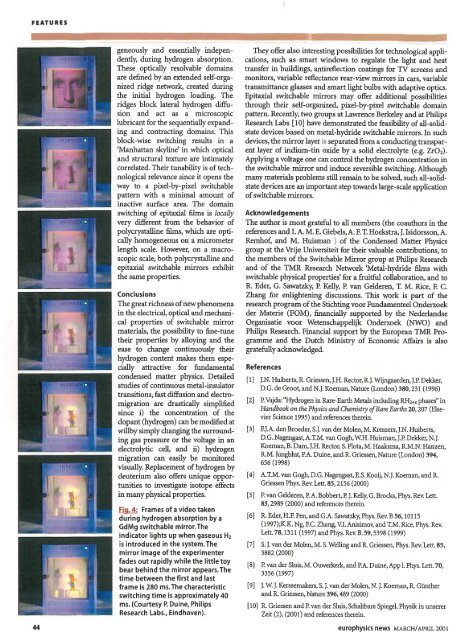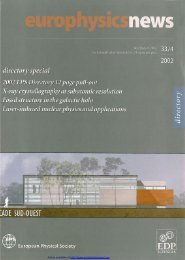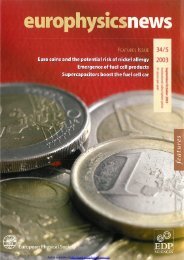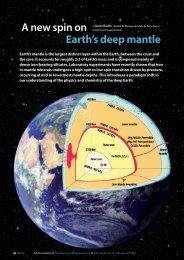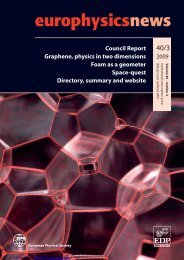Whole issue in PDF - Europhysics News
Whole issue in PDF - Europhysics News
Whole issue in PDF - Europhysics News
You also want an ePaper? Increase the reach of your titles
YUMPU automatically turns print PDFs into web optimized ePapers that Google loves.
FEATURES<br />
geneously and essentially <strong>in</strong>dependently,<br />
dur<strong>in</strong>g hydrogen absorption.<br />
These optically resolvable doma<strong>in</strong>s<br />
are def<strong>in</strong>ed by an extended self-organized<br />
ridge network, created dur<strong>in</strong>g<br />
the <strong>in</strong>itial hydrogen load<strong>in</strong>g. The<br />
ridges block lateral hydrogen diffusion<br />
and act as a microscopic<br />
lubricant for the sequentially expand<strong>in</strong>g<br />
and contract<strong>in</strong>g doma<strong>in</strong>s. This<br />
block-wise switch<strong>in</strong>g results <strong>in</strong> a<br />
'Manhattan skyl<strong>in</strong>e' <strong>in</strong> which optical<br />
and structural texture are <strong>in</strong>timately<br />
correlated. Their tunability is oftechnological<br />
relevance s<strong>in</strong>ce it opens the<br />
way to a pixel-by-pixel switchable<br />
pattern with a m<strong>in</strong>imal amount of<br />
<strong>in</strong>active surface area. The doma<strong>in</strong><br />
switch<strong>in</strong>g of epitaxial films is locally<br />
very different from the behavior of<br />
polycrystall<strong>in</strong>e films, which are optically<br />
homogeneous ona micrometer<br />
length scale. However, on a macroscopic<br />
scale, both polycrystall<strong>in</strong>e and<br />
epitaxial switchable mirrors exhibit<br />
the same properties.<br />
Conclusions<br />
The great richness ofnewphenomena<br />
<strong>in</strong> the electrical, optical and mechanical<br />
properties of switchable mirror<br />
materials, the possibility to f<strong>in</strong>e-tune<br />
their properties by alloy<strong>in</strong>g and the<br />
ease to change cont<strong>in</strong>uously their<br />
hydrogen content makes them especially<br />
attractive for fundamental<br />
condensed matter physics. Detailed<br />
studies of cont<strong>in</strong>uous metal-<strong>in</strong>sulator<br />
transitions, fast diffusion and electromigration<br />
are drastically simplified<br />
s<strong>in</strong>ce i) the concentration of the<br />
dopant (hydrogen) canbe modified at<br />
willbysimplychang<strong>in</strong>g the surround<strong>in</strong>g<br />
gas pressure or the voltage <strong>in</strong> an<br />
electrolytic cell, and ii) hydrogen<br />
migration can easily be monitored<br />
visually. Replacement of hydrogen by<br />
deuterium also offers unique opportunities<br />
to <strong>in</strong>vestigate isotope effects<br />
<strong>in</strong> manyphysical properties.<br />
Fig.4: Frames of a video taken<br />
dur<strong>in</strong>g hydrogen absorption by a<br />
GdMg switchable mirror. The<br />
<strong>in</strong>dicator lights up when gaseous H2<br />
is <strong>in</strong>troduced <strong>in</strong> the system.The<br />
mirror image of the experimenter<br />
fades out rapidly while the little toy<br />
bear beh<strong>in</strong>d the mirror appears.The<br />
time between the first and last<br />
frame is 280 ms. The characteristic<br />
switch<strong>in</strong>g time is approximately 40<br />
ms. (Courtesy P. Du<strong>in</strong>e, Philips<br />
Research Labs., E<strong>in</strong>dhoven).<br />
They offer also <strong>in</strong>terest<strong>in</strong>g possibilities for technological applications,<br />
such as smart w<strong>in</strong>dows to regulate the light and heat<br />
transfer <strong>in</strong> build<strong>in</strong>gs, antireflection coat<strong>in</strong>gs for TV screens and<br />
monitors, variable reflectance rear-view mirrors <strong>in</strong> cars, variable<br />
transmittance glasses and smart light bulbs with adaptive optics.<br />
Epitaxial switchable mirrors may offer additional possibilities<br />
through their self-organized, pixel-by-pixel switchable doma<strong>in</strong><br />
pattern. Recently, two groups at Lawrence Berkeley and at Philips<br />
Research Labs [10] have demonstrated the feasibility of all-solidstate<br />
devices based on metal-hydride switchable mirrors. In such<br />
devices, the mirrorlayer is separatedfrom a conduct<strong>in</strong>gtransparent<br />
layer of <strong>in</strong>dium-t<strong>in</strong> oxide by a solid electrolyte (e.g. ZrOz).<br />
Apply<strong>in</strong>g a voltage one can control the hydrogen concentration <strong>in</strong><br />
the switchable mirror and <strong>in</strong>duce reversible switch<strong>in</strong>g. Although<br />
many materials problems still rema<strong>in</strong> to be solved, such all-solidstate<br />
devices are an importantstep towards large-scale application<br />
ofswitchable mirrors.<br />
Acknowledgements<br />
The author is most grateful to all members (the coauthors <strong>in</strong> the<br />
references and 1. A. M. E. Giebels,A. F. T. Hoekstra, J. Isidorsson,A.<br />
Remhof, and M. Huisman ) of the Condensed Matter Physics<br />
group at the Vrije Universiteit for their valuable contributions, to<br />
the members of the Switchable Mirror group at Philips Research<br />
and of the TMR Research Network 'Metal-hydride films with<br />
switchable physical properties' for a fruitful collaboration, and to<br />
R. Eder, G. Sawatzky, P. Kelly, P. van Gelderen, T. M. Rice, F. C.<br />
Zhang for enlighten<strong>in</strong>g discussions. This work is part of the<br />
research program ofthe Sticht<strong>in</strong>gvoor Fundamenteel Onderzoek<br />
der Materie (FOM), f<strong>in</strong>ancially supported by the Nederlandse<br />
Organisatie voor Wetenschappelijk Onderzoek (NWO) and<br />
Philips Research. F<strong>in</strong>ancial support by the European TMR Programme<br />
and the Dutch M<strong>in</strong>istry of Economic Affairs is also<br />
gratefully acknowledged.<br />
References<br />
[1] J.N. Huiberts, R. Griessen, J.H. Rector, R.J. Wijngaarden, J.P. Dekker,<br />
D.G. de Groot, and N.J. Koernan, Nature (London) 380,231 (1996)<br />
[2] P. Vajda: "Hydrogen <strong>in</strong> Rare~Earth Metals <strong>in</strong>clud<strong>in</strong>g RH 2+ x phases" <strong>in</strong><br />
Handbook on the Physics and Chemistry ofRare Earths 20, 207 (Elsevier<br />
Science 1995) and references there<strong>in</strong>.<br />
[3] EJA den Broeder, S.J. van der Molen, M. Kremers, J.N. Huiberts,<br />
D.G. Nagengast, A.T.M. van Gogb, W:H. Huisman, J.P. Dekker, N.J.<br />
Koeman, B. Dam, J.H. Rector, S. Plota, M. Haaksma, R.M.N. Hanzen,<br />
R.M. Jungblut, P.A. Du<strong>in</strong>e, and R. Griessen, Nature (London) 394,<br />
656 (1998)<br />
[4] A.T.M. van GOgb, D.G. Nagengast, E.S. Kooij, N.J. Koeman, and R.<br />
Griessen Phys. Rev. Lett. 85, 2156 (2000)<br />
[5] P. van Gelderen, P.A. Bobbert, P. J. Kelly, G. Brocks, Phys. Rev. Lett.<br />
85,2989 (2000) and references there<strong>in</strong>.<br />
[6] R. Eder, H.E Pen, and G.A. Sawatzky, Phys. Rev. B56, 10115<br />
(1997);K.K. Ng, EC. Zhang, v.I.Anisimov, and T.M. Rice, Phys. Rev.<br />
Lett. 78, 1311 (1997) and Phys. Rev.B. 59, 5398 (1999)<br />
[7] S. J. van der Molen, M. S. Well<strong>in</strong>g and R. Griessen, Phys. Rev. Lett. 85,<br />
3882 (2000)<br />
[8] P. van der Sluis, M. Ouwerkerk, and P.A. Du<strong>in</strong>e, App LPhys. Lett. 70,<br />
3356 (1997)<br />
[9] J.w. J. Kerssernakers, S. J. van der Molen, N. J. Koernan, R. Gi<strong>in</strong>ther<br />
and R. Griessen, Nature 396, 489 (2000)<br />
[10] R. Griessen and P. van der Sluis, Schaltbare Spiegel, Physik <strong>in</strong> unserer<br />
Zeit (2), (2001) and references there<strong>in</strong>.<br />
44<br />
europhysics news MARCH!APRIL 2001


